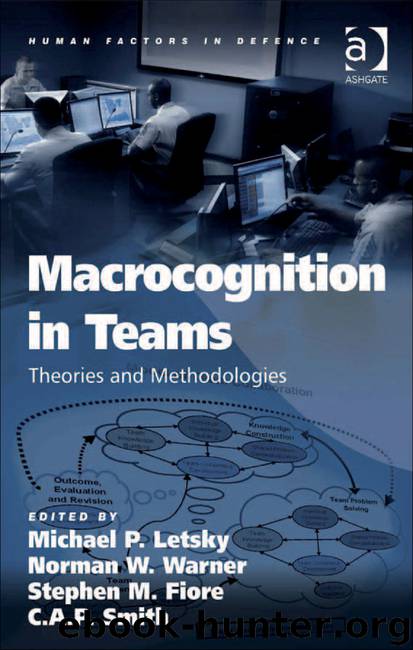Macrocognition in Teams by Michael P. Letsky & Norman W. Warner & Stephen M. Fiore & C.A.P. Smith

Author:Michael P. Letsky & Norman W. Warner & Stephen M. Fiore & C.A.P. Smith
Language: eng
Format: epub
Publisher: Ashgate
Published: 2008-03-14T16:00:00+00:00
Transformation agents
The task of the transformation agents is to adjust the flow of information among humans and computational systems by providing individual users with a customized selection of potentially relevant information in their individual Kiosk views (Figure 11.3, transformation agents). The relevance of information is determined based on an analysis of the contents in the database (created and managed by the interpretation agents). Because the database reflects and interrelates current and past contributions from different users it provides a rich source of information for transformation agents to learn about the knowledge and expertise of users, the current foci and interests of users, the interactions among users, as well as the collaborative use of information. Every individual transformation agent specializes on one particular aspect when determining the relevance of information for a particular user. For example, one transformation agent might search the database for Cards that maintain relationships with Cards on the user’s Workspace view. Another might increase the relevance of Cards that were created by authors from whom the user previously copied Cards. The relevance of information does not necessarily satisfy the interests of one particular user but a community of collaborating users as a whole. For example, if a Card were to be used by all but one collaborating user then a particular transformation agent might increase the relevance of this Card for the one user who is not yet using it. The selection and prioritized sequences of Cards from different transformation agents are combined and displayed on the user’s Kiosk view.
Group 1 A first group of transformation agents is focused on facilitating team building as well as converging individual user investigations and foci. These agents select and prioritize Cards based on a comparison of the contents and evolution of individual users’ Card arrangements as well as the collaborative exchange of information. A few examples of transformation agents in this group are outlined below.
The interaction agent1 accelerates the information exchange among users that previously benefited from each others contributions. This particular agent prioritizes Cards based on user interactions. An interaction is registered whenever a user copies or views a Card from another user, whenever two users communicate through a Card’s instant messaging feature, or whenever an interpretation agent generates a relationship between two Cards created by different authors. Cards are prioritized based on how many interactions the Card recipients have with the Card authors. The interaction agent enables an environment in which users might implicitly and unknowingly start collaborating in teams with unique task foci. The selective exchange of information among team participants also allows for a less interruptive and more efficient development of team knowledge2.
The balance agent1 prioritizes Cards based on the orderliness and modification frequency of Card arrangements. An unstructured arrangement of Cards is more typical during the early stages of sense-making sessions when people primarily focus on exploring and collecting information. A structured arrangement of Cards is more typical during the end of sense-making sessions when people conclude their analyses and organization of information. The goal
Download
This site does not store any files on its server. We only index and link to content provided by other sites. Please contact the content providers to delete copyright contents if any and email us, we'll remove relevant links or contents immediately.
Hit Refresh by Satya Nadella(9083)
The Compound Effect by Darren Hardy(8870)
Change Your Questions, Change Your Life by Marilee Adams(7684)
Nudge - Improving Decisions about Health, Wealth, and Happiness by Thaler Sunstein(7657)
The Black Swan by Nassim Nicholas Taleb(7056)
Deep Work by Cal Newport(6966)
Rich Dad Poor Dad by Robert T. Kiyosaki(6513)
Daring Greatly by Brene Brown(6473)
Principles: Life and Work by Ray Dalio(6296)
Playing to Win_ How Strategy Really Works by A.G. Lafley & Roger L. Martin(6083)
Man-made Catastrophes and Risk Information Concealment by Dmitry Chernov & Didier Sornette(5956)
Digital Minimalism by Cal Newport;(5704)
Big Magic: Creative Living Beyond Fear by Elizabeth Gilbert(5677)
The Myth of the Strong Leader by Archie Brown(5457)
The Slight Edge by Jeff Olson(5376)
Discipline Equals Freedom by Jocko Willink(5336)
The Motivation Myth by Jeff Haden(5175)
The Laws of Human Nature by Robert Greene(5080)
Stone's Rules by Roger Stone(5052)
